
Problem of the Day Test Prep: Language, Strategies and Building Confidence
Authors:Kayla Fortenberry, Eastfield Global Elementary, McDowell County Schools
Students are not performing well on tests because the types of questions they saw on the test do not directly align with the questions and instructions in class. The question I set out to answer was: “Would students' course performance in math be improved if they were given a work session during the math block prior to the day of assessment with similar questions to the types of problems they would see on the test?”
Carrie Franklin, Glennwood Elementary, McDowell County Schools
I saw Kayla’s idea and thought it could be useful for younger students too. I also saw students who got anxious during assessments and didn’t perform as well as I knew they could. Sometimes we just don’t give kids enough time to get used to different presentations of the same math procedures. I believed that exposing them more frequently to the kinds of questions they would see on assessments would increase their familiarity with the language used, build their confidence and decrease their anxiety. But instead of using “study guides,” I adapted this improvement idea to use Problems of the Day. Like Kayla, I used backward design to make sure that I was constructing the Problems of the Day using the same language they would see on assessments
Allyson Rideout, West McDowell Elementary, McDowell County Schools
This idea was tested with three fourth grade students that scored below 70% on classroom assessments. I worked with these students in a small group for 10 minutes 2-3 times a week during our math block to work on problems of the day from SchoolNet matching the standard we were working on or had covered previously to help them get used to the language and presentation of the types of math problems they will see on assessments…After students had shown improvement using the Problem of the Day Strategy, I decided to begin pulling back on the support. Instead of receiving the support in a small-group setting, my students received the support with the rest of their classmates in the whole-group setting.
The Process
I chose this as my focus because these were five students in my 3rd grade class performing well in class, but not doing well on math assessments. I was concerned that they were not performing well on tests because the types of questions they saw on the test did not directly align with instruction in class. I decided to create study guides with "backward design" questions and work through these specific problem types during our math block the day before the test. We had our first math test of the year in September 2020 and I began implementing this strategy after this test with change data beginning in October 2020.
I used our 3rd grade assessments from SchoolNet to create "backward design" question stems for the study guides. The tests were already created by a colleague and agreed upon as a team for instructional purposes. I created the study guides and shared them with my team, as well as engaged all my students in these work sessions prior to math assessments.
Typically, the "work sessions" happen the day before our scheduled math assessment. I do it with all students, not just the "targeted" ones for this specific PDSA. I tell students that these are the same skills we have been working on in class (addition, subtraction, word problems, rounding, etc.) but with questions that look similar to what is going to be on the test. That way, they are comfortable with the structure and format of how questions are being asked prior to the test and focus on skill application vs. question dissection. If it is a difficult skill or questions that require multiple steps, sometimes we break this into two days of math instruction. When we are finished with the study guide, students then take this home with them and have the option to review at home prior to the test. (Kayla Fortenberry, Eastfield Global Elementary, McDowell County Schools)
-
Impact
Kayla Fortenberry's Third Grade Students
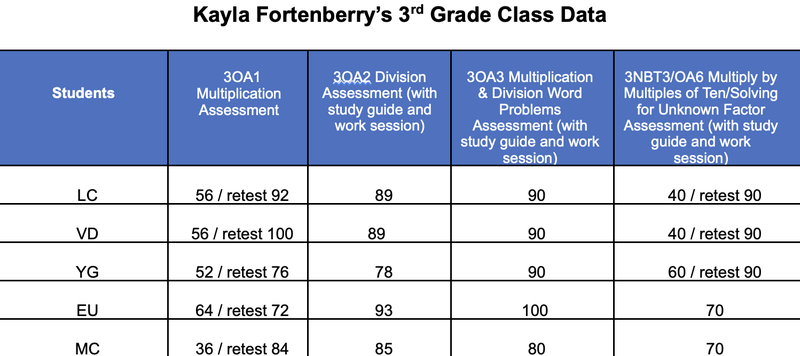
- Original test scores increased significantly for all five students and the need for remediation/re-teaching and re-testing decreased for all five students.
- Study guides have resulted in consistent growth for these five students.
- Two out of five students are consistently using guides at home (VD, EU).
- These results lead me to believe that the work sessions in class are more useful than studying at home for the majority of students in this group. Also using study guides with backward design questions that are similar to test question stems during remediation to retest have also shown an increase in test scores.
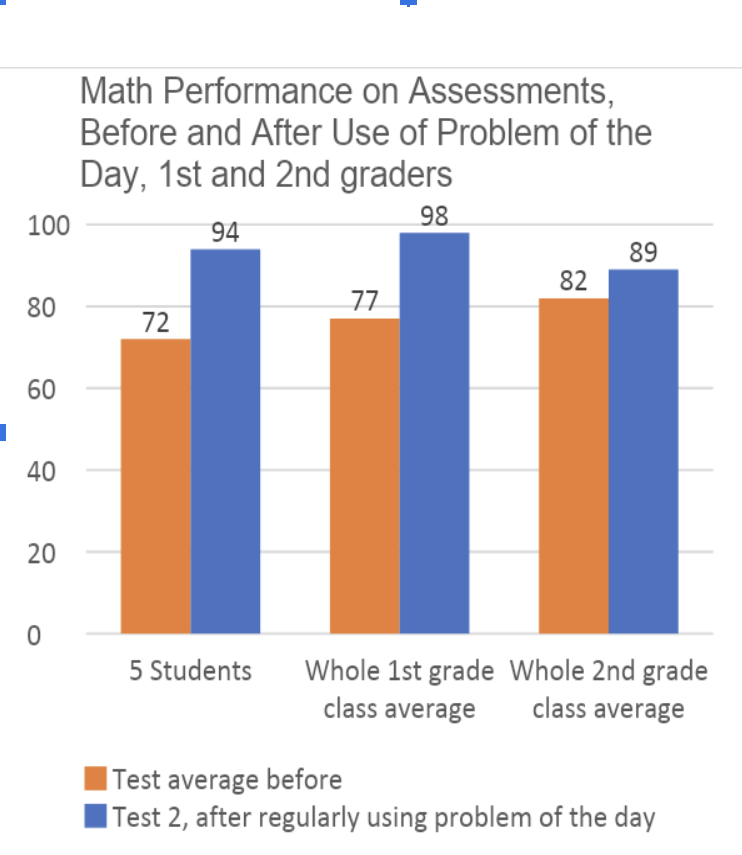
- This idea was adopted into instructional practice and implement with the whole first and grade. The first grade test average before this idea was 77 percent and increased to 98 percent. The second grade test average was 82 percent before and increased to 89 percent.
Carrie Franklin's First and Second Grade Students
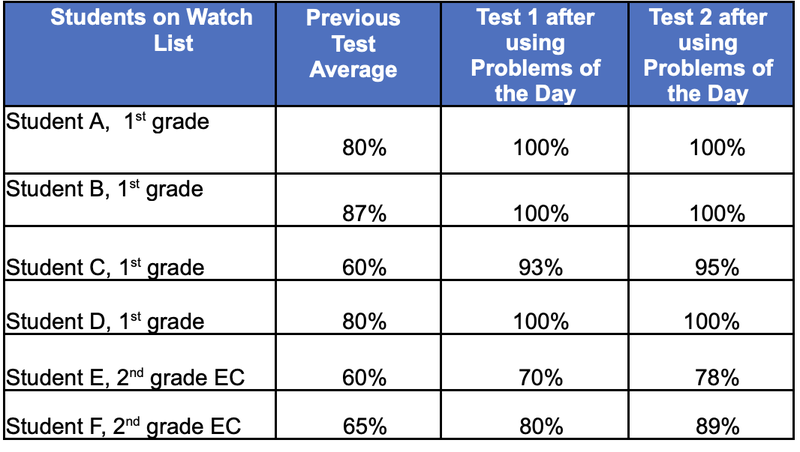
- 5 out of 5 students improved their scores on math assessments (from an average of 72% to an average of 94%) In addition, the class averages for 1st graders improved from 77% to 98% and class averages for 2nd graders improved from 82% to 89%.
Allyson Rideout's Third Grade Students
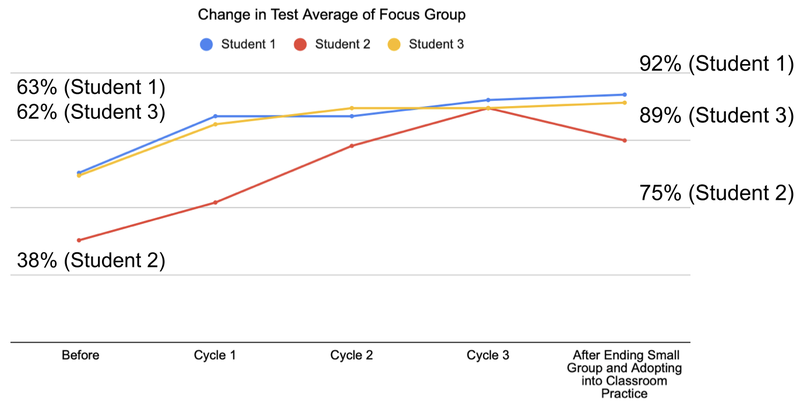
- 3 out of 3 students improved their average math assessment score. Student 1 increased their math assessment average from 63% to 92%. Student 2 increased their math assessment average from 38% to 75%. Student 3 increased their math assessment average from 62% to 89%.
-
Practical Keys to Success
Kayla Fortenberry, Eastfield Global Elementary, McDowell County Schools
- I take screenshots or post pictures to Class Dojo of "my work" that I have done during work sessions under the document camera with students, so parents have an "answer key" to reference. This works best for my third graders who still rely a great deal on parent support at home for study habits, but I could see putting this on Google Classroom or Canvas or any other learning management system for older students who are able to independently study.
- I typically do not let students use the study guide on the actual test, but I could see this being a beneficial accommodation for some students, depending on their situation.
- I would warn anyone trying to implement this that there is a time component: You do have to put in the time to create specific questions that are similar in structure, language, and answer choices as the test for this to be as effective as possible. Our school has a "Team Drive" on Google, so I upload the ones I create in a folder there so it is available for future reference and I won't have to reinvent the wheel next year when I am teaching these standards
Jennifer Blake 4th grade, Katie Carter 5th grade Glenwood Elementary, McDowell County School
- We are now using Kayla’s Study Guide idea across the entire 4th grade. We go over it, talk about it explicitly and let them ask questions. It is a teaching tool, not a standalone.
- We use a Common Formative Assessment and work as a 4th grade team together to rewrite our study guide so that it is formatted and looks just like their formative assessment - just the same terminology and question stems We use it every time we give a Common Formative Assessment. Now we take turns on who writes the study guide, which shows other teachers’ investment in the process.
-
Measurement
- Use a table to collect data.
- Collect the previous test average of 3 or more test.
- Record the scores for subsequent test. Calculate the average of the test scores and compare to the baseline average. Analyze the data.
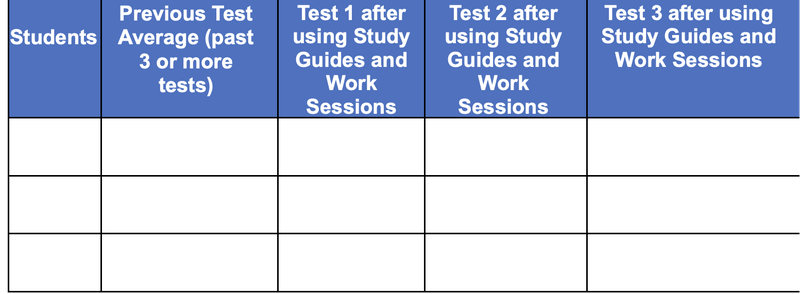
Email Schools That Lead to request a sample data collection spreadsheet and student missing assignment tracker.








